More.
Wednesday, September 19, 2018
Adventures in Homebrewing had a free shipping sale going on, so Dan and I went in together and bought two more fermenting buckets.
It’s a long wait from fermenting to bottling to enjoying. The rare optimistic outlook that I will in the future be able to enjoy them. Thus far, not much success.
My plan is to do a batch of apple jack, which has to live in the fermenter for a month or more. Also, in the future, it would be nice to have a couple of batches going at a time at different stages.
Brew Day – Summer Ale
Tuesday, September 18, 2018
Dan had previously brewed this Brewer’s Best Summer Ale recipe with great and easy success. As with my previous batch, my intent was to do something interesting with the recipe.
Code name: Fale All (lowered expectations Fall Ale)
I set aside the bag of dried lemon and orange peel that came with the recipe kit. Instead, I bought three big naval oranges, cloves, and cinnamon. I zested all three oranges into a big wet, oily pile, mixed in ten cloves, and covered it all in ground cinnamon. I left this in the refrigerator overnight, wrapped in plastic.
I got the idea from a recipe I found online for homemade Constant Comment tea. A fall ale seemed more appropriate for this time of year.
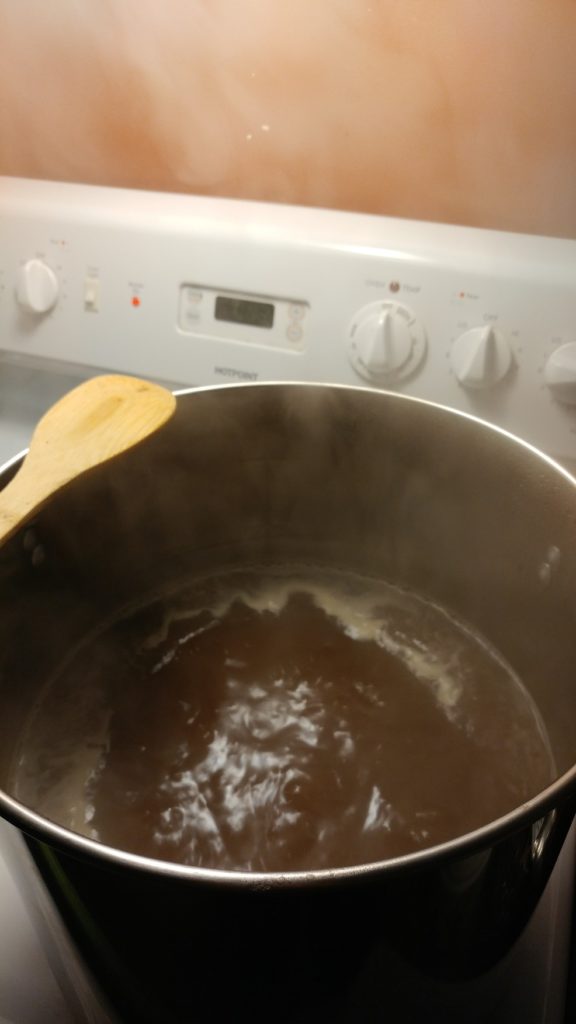
I added the orange, clove, and cinnamon into the last ten minutes of the boil. Before transferring over to the fermenter, I strained out all of the cloves and orange zest.
Original Gravity: 1.042
Brew day went off without a hitch.
Bottling Day – Backyard Pilsner – Part Two
Sunday, September 16, 2018
Code name: Strawbeery
After a week in secondary with strawberries, it was time to bottle the remaining four gallons. The strawberries had turned yellowish-gray and the beer was pink.
Because of the problems with the butterfly capper the previous weekend, I designed and built “The Capperatus” from scrap 2×6 blocks that were laying around in the basement. I used a hole saw that was large enough to fit a soup can. A couple of layers of microfiber rags made for a snug fit inside and outside of the can. Also, it couldn’t hurt to have a little cushion.
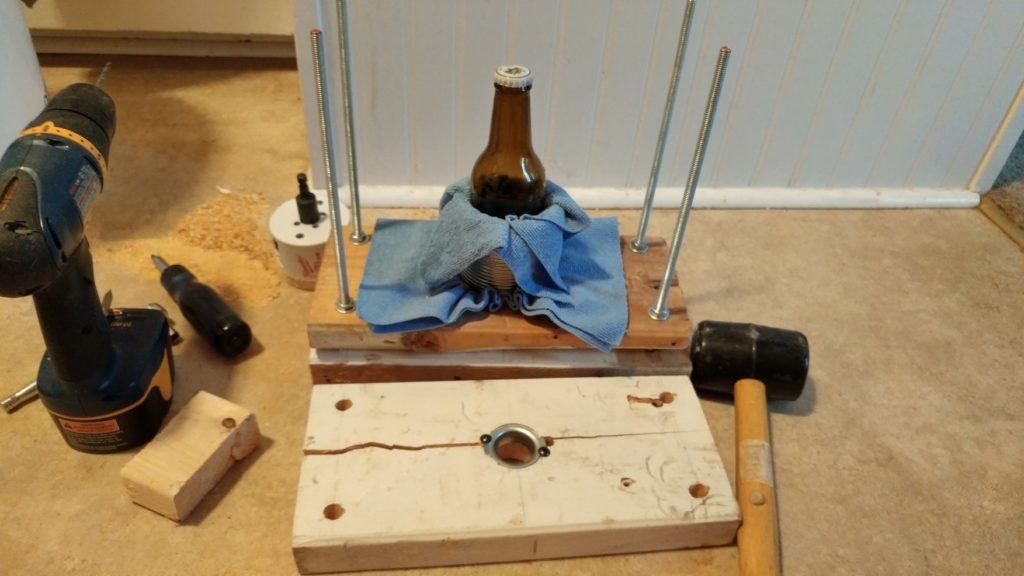
After a couple of trial runs, the top wood block split, but otherwise the concept worked well.
I scooped out all of the strawberry sludge from the gallon jars and racked into the bottling bucket with the remaining 80% of the priming sugar.
Since the top block of The Capperatus split in testing, I capped the bottles using the bottom half to keep the bottles stable. It did a great job of that. I used the aforementioned “John Henry” rubber mallet technique without incident.
Tasting – Backyard Pilsner
Saturday, September 15, 2018
With a bit of nerves, I cracked open my first bottle of my first batch of beer.
It didn’t have much carbonation. What it did have, in abundance, was a medicinal smell. It smelled and tasted like I had fermented the IO Star sanitizer.
Not great.
Luckily, there is only one gallon of this mess. Let’s hope the strawberry batch turns out better.
Bottling Day – Backyard Pilsner – Part One
Sunday, September 9, 2018
I took the four glass fermenting jars and added varying amounts of strawberries that had soaked overnight in vodka. The idea was to later bottle the beer individually out of these jars and figure out which ratio of strawberries to beer tasted best.
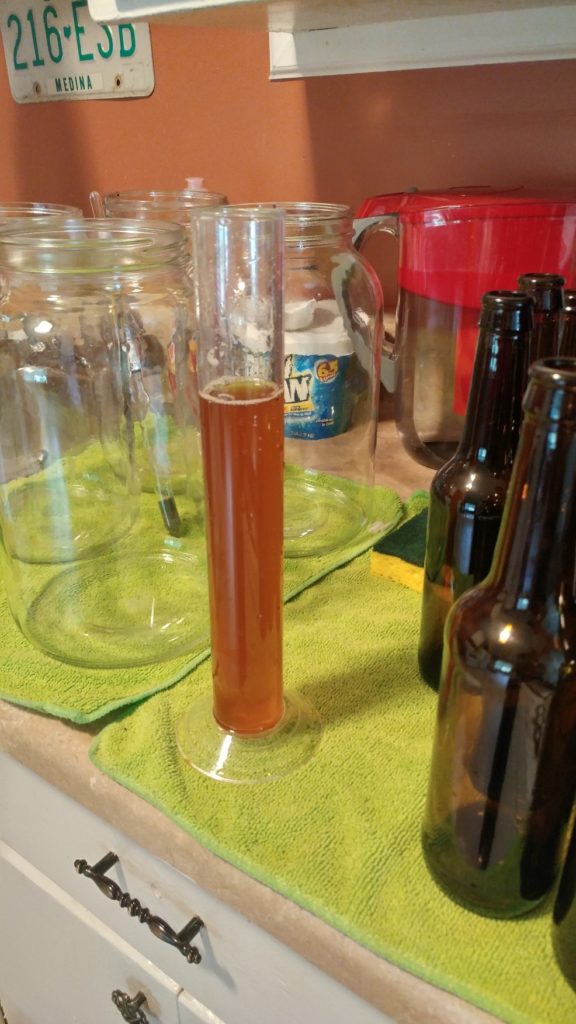
For some reason, final gravity measured 1.040, which was exactly the same as the original gravity. This made me question my ability to read the hydrometer. Either that, or the accuracy of the hydrometer.
The beer tasted strange – heavy and medicinal. That is not what I was expecting from a pilsner.
I prepared roughly 20% of a 5oz pack of priming sugar (calculated in tablespoons) and racked the remaining gallon of beer into the bottling bucket.
Bottling went smoothly. However, the capping did not. The butterfly capper that came with my brew kit didn’t grab these bottle necks properly. It was clamping metal plates directly against the bottle necks.
Fearing I would break or at least crack a bottle neck, I abandoned the capper. I had previously read someone else’s tale of having the same problem. Their emergency bottling day solution was to whack the removable capper bell with a rubber mallet.
I did the same.
No bottles were broken, but what a shit show…
Mr. Boston’s Strawberry Bath
Friday, September 7, 2018
The plan is to try making this plain ol’ pilsner recipe a little more interesting. I’m going to split off some of the beer into secondary fermenter with added strawberries. I bought a five pound bag of frozen jumbo strawberries at the grocery store.
To keep from introducing bacteria or stray yeast into your brew, a common practice is to soak additives in vodka. As with everything else, online opinions vary on the frozen strawberries, whether or not they need to be sanitized.
I decided to play it safe and soaked them overnight in vodka in the refrigerator. I bought a handle of the cheapest vodka I could find – Mr. Boston’s Riva Vodka – for $11.
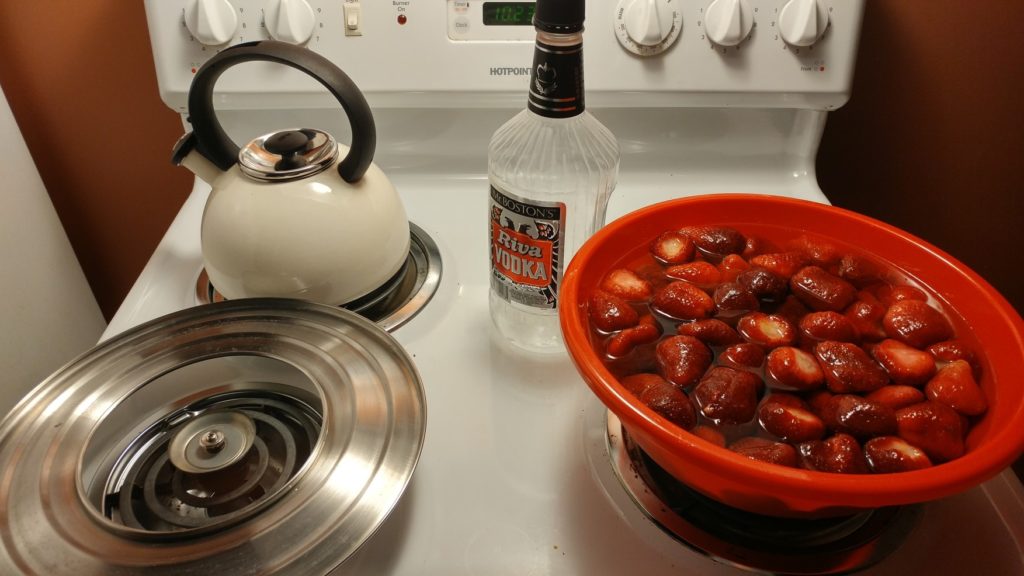
How to turn glass jars into glass shards
Thursday, August 30, 2018
Since I have fairly low expectations for how this first batch is going to turn out, I decided to play with the recipe and make a strawberry brew.
I ordered four one-gallon fermenting jars with lids, a bag of twenty rubber grommets, and six three-piece airlocks from Amazon. The package arrived with one of the glass jars broken. “Broken” probably isn’t the right word.
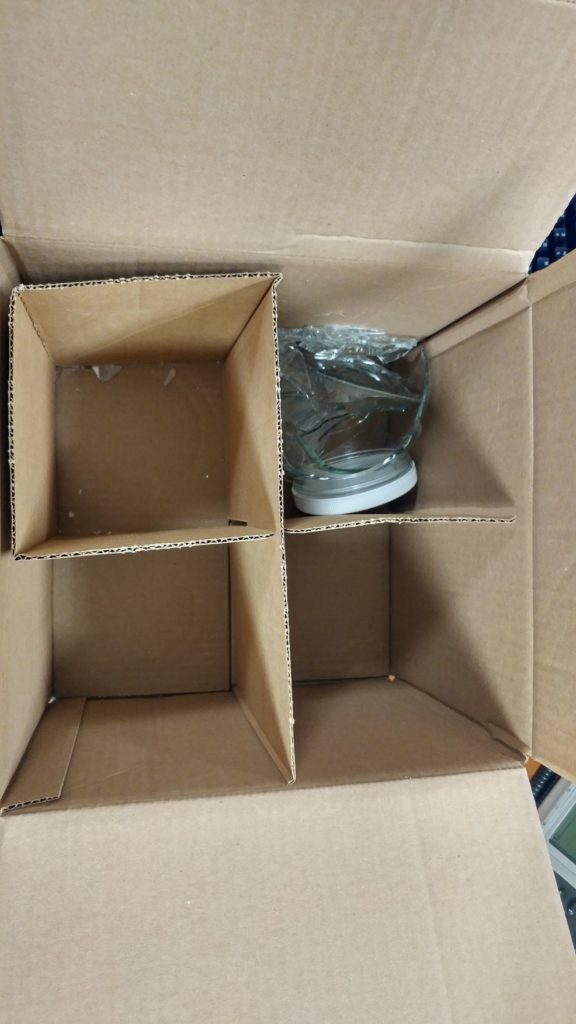
The pictures of the item on Amazon showed the individual jars wrapped in bubble wrap. However, the package arrived with bubble wrap around the outside of the inner box, leaving the jars to flop around inside the box with only the divider in between.
Amazon credited a portion of the purchase price and I ordered a single jar and four spare lids. I split a couple of the original lids trying to drill the hole out for the airlock grommets.
Fifth Season
Wednesday, August 29, 2018
I stopped by Fifth Season, a local homebrew supply shop, after work and picked up a few things.
First, I needed priming sugar, since I didn’t know to add it to the Adventures in Homebrew recipe page. Also, I picked up the 24″ plastic brew paddle that my kit was missing. Lastly, while I was there, I looked through their Brewer’s Best rack and picked up a Summer Ale recipe kit.
This recipe kit is the first one that Dan brewed and it turned out great.
Cool it!
Monday, August 27, 2018
I picked up a plastic tote at Kmart on my way home from work. Filled it with water and parked the fermenter in it.
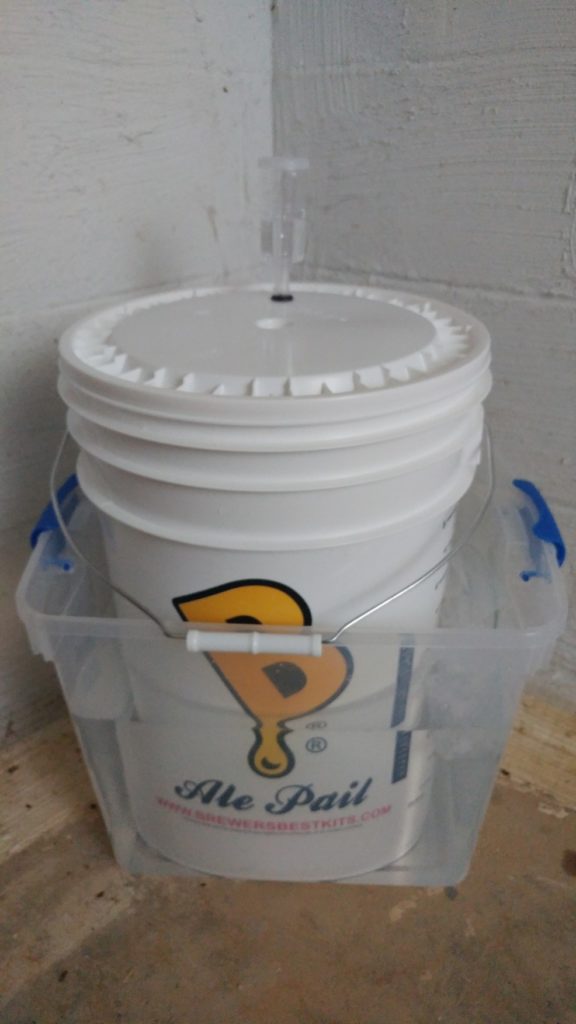
Once or twice a day, I dropped a plastic freezer bag full of ice cubes in to cool it down some more. This took the temperature of the fermenter from 75° down to 70-72°
A few days later, I bought a twelve pack of grocery store brand 12oz water bottles and froze them. Using those, I was able to stop messing with freezer bags full of ice cubes and could drop the frozen bottles more frequently, two to three times a day. This got the temperature down to 68-70°.
Also, the peel and stick thermometer that came with the brew kit isn’t water proof. After a couple of days in the water, the outer plastic layer peeled off, rendering it unreadable.
Brew Day – Backyard Pilsner
Saturday, August 25, 2018
Brewing Backyard Pilsner recipe from Adventures in Homebrewing. Recipe says “Gradually bring up to 150-160” like I have the option of doing it quickly…
Doing all of this for the first time, it’s a little disjointed – not having things ready when I need them or within easy reach when my hands are full. Anyway, it went smoothly, all things considered.
In preparation for this day, I had frozen some beer cans full of water, ready for the ice bath at the end of the boil. Turns out, don’t freeze cans. The expanding ice opens up a door in the side of the can, almost perfectly uniform across all of them.
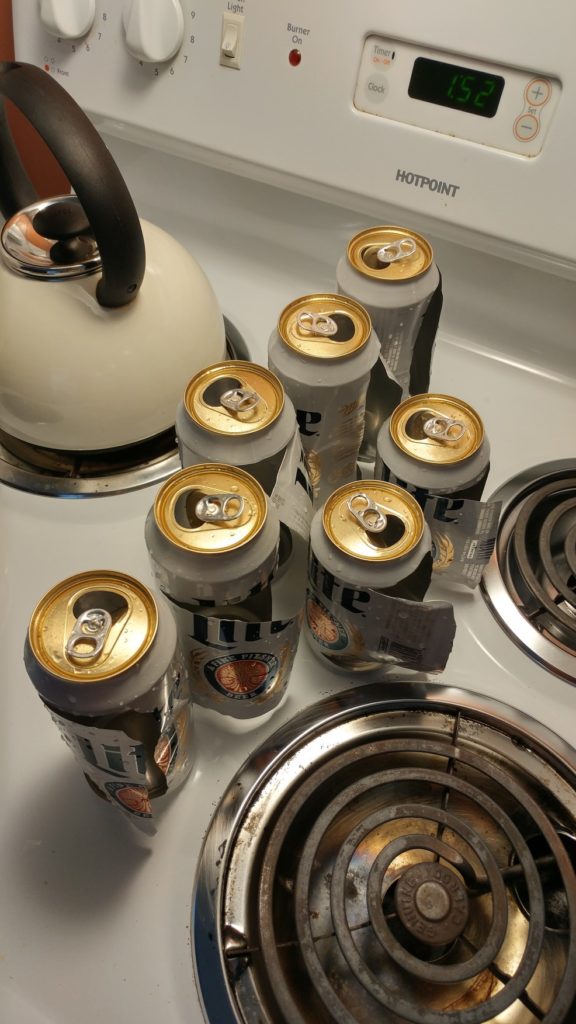
Regardless, they worked well to cool down the wort. I tied some cord with a long twist tie to the end of my thermometer and hung it from the knob on the cabinet door above the sink.
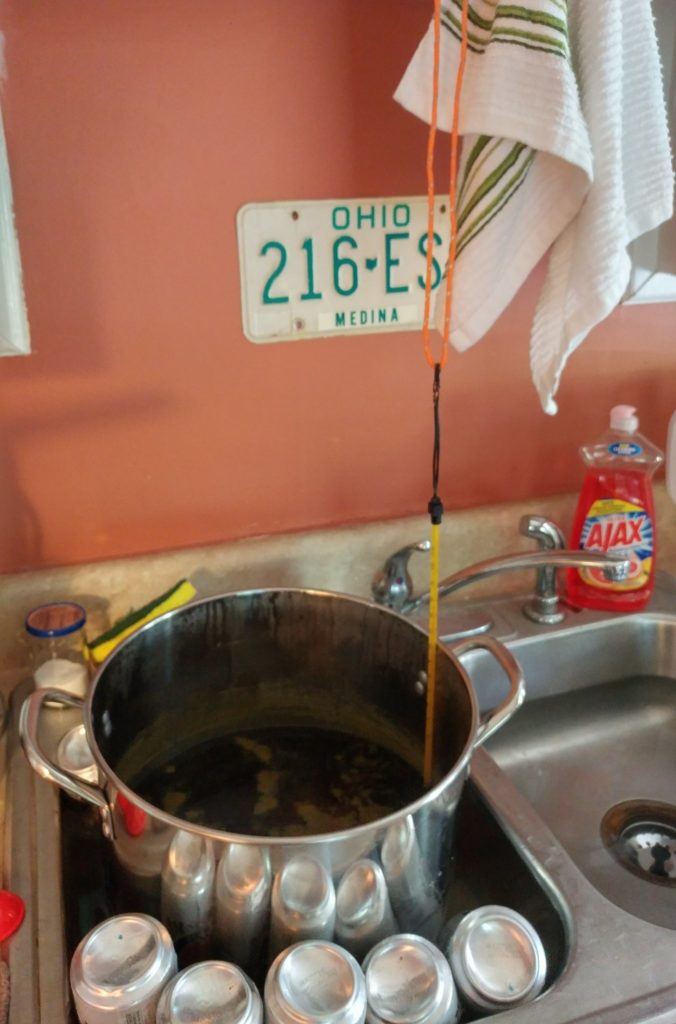
The Original Gravity measured 1.040. The recipe projected 1.048.
I moved the fermenter down to the basement, since it is the coolest place in the house. Unfortunately, in the summer, it’s still 75° down there, which is near the top of the range for the Safale US-05 yeast.